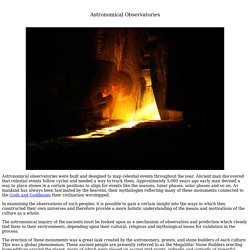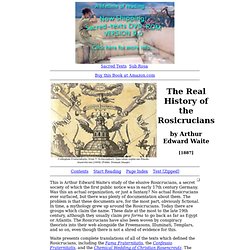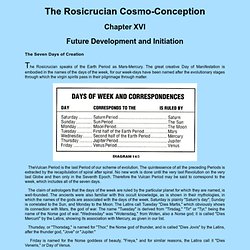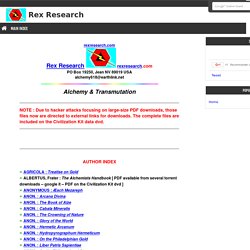

Astronomical Observatories. Astronomical Observatories Astronomical observatories were built and designed to map celestial events throughout the year.

Ancient man discovered that celestial events follow cycles and needed a way to track them. Approximately 5,000 years ago early man devised a way to place stones in a certain positions to align for events like the seasons, lunar phases, solar phases and so on. As mankind has always been fascinated by the heavens, their mythologies reflecting many of these monuments connected to the Gods and Goddesses their civilization worshipped. In examining the observations of such peoples, it is possible to gain a certain insight into the ways in which they constructed their own universes and therefore provide a more holistic understanding of the means and motivations of the culture as a whole.
The erection of these monuments was a great task created by the astronomers, priests, and stone builders of each culture. Astronomical Observatories Around the World Spain England Ireland Egypt. Megalithic Sites. The Real History of the Rosicrucians Index. Sacred Texts Sub Rosa Buy this Book at Amazon.com Contents Start Reading Page Index Text [Zipped] This is Arthur Edward Waite's study of the elusive Rosicrucians, a secret society of which the first public notice was in early 17th century Germany.

Was this an actual organization, or just a fantasy? No actual Rosicrucians ever surfaced, but there was plenty of documentation about them. Waite presents complete translations of all of the texts which defined the Rosicrucians, including the Fama Fraternitatis, the Confessio Fraternitatis, and the Chemical Wedding of Christian Rosencreutz. The Real History stands in stark contrast to Hargrave Jennings' The Rosicrucians, their Rites and Mysteries, which Waite (justifiably) criticizes throughout. All in all, this serves both as a survey of the literature about Rosicrucians and an invaluable anthology of that literature. Title PageAnalysis of ContentsPrefaceIntroductionChapter I. Chapter V. Chapter XIII. The Rosicrucian Cosmo-Conception, by Max Heindel. Chapter XVI Future Development and Initiation The Seven Days of Creation The Rosicrucian speaks of the Earth Period as Mars-Mercury.

The great creative Day of Manifestation is embodied in the names of the days of the week, for our week-days have been named after the evolutionary stages through which the virgin spirits pass in their pilgrimage through matter. TheVulcan Period is the last Period of our scheme of evolution. The claim of astrologers that the days of the week are ruled by the particular planet for which they are named, is well-founded. Thursday, or "Thorsdag," is named for "Thor," the Norse god of thunder, and is called "Dies Jovis" by the Latins, after the thunder god, "Jove" or "Jupiter.
" Friday is named for the Norse goddess of beauty, "Freya," and for similar reasons, the Latins call it "Dies Veneris," or Day of Venus. Occult science teaches that there are 777 incarnations, but that does not mean that the Earth undergoes 777 metamorphoses. Spirals within Spirals. Rex Research: Alchemy Index. Rexresearch.com Rex Research rexresearch.com PO Box 19250, Jean NV 89019 USA alchemy618@earthlink.net Alchemy & TransmutationNOTE : Due to hacker attacks focusing on large-size PDF downloads, those files now are directed to external links for downloads.

The complete files are included on the Civilization Kit data dvd. R.A.M.S. Digital Library. Rosicrucianism. Societas Rosicruciana in Anglia.